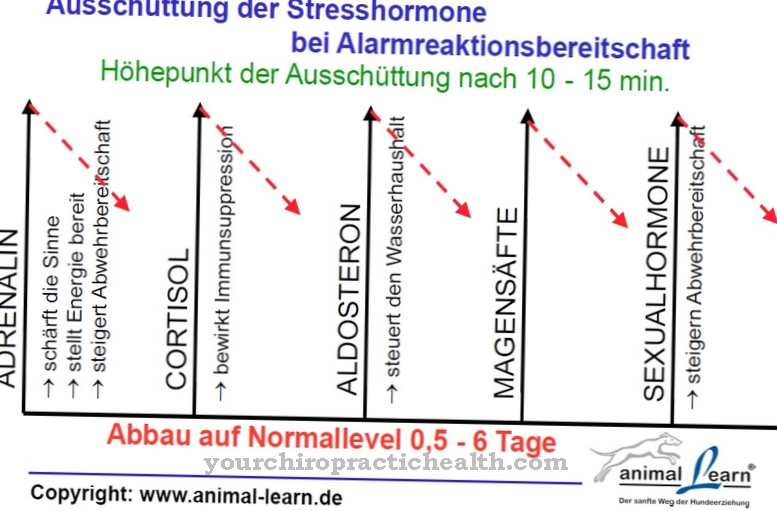Oxytocin is a much-discussed subject, not least in connection with its important function in the social fabric. Colloquially, oxytocin is known as the "bonding hormone".
What is oxytocin?
Oxytocin (also called oxitozin) is both a hormone and a neurotransmitter with a central role in the birth process.
At the same time, oxytocin influences the behavior between humans (and animals) among one another. It plays a huge role in social interaction.
Production, manufacturing & education
Oxytocin is produced in the hypothalamus, more precisely in the paraventricular nucleus and also, albeit less, in the supraoptic nucleus. There it is channeled via so-called axons to the neurohypophysis of the pituitary gland (pituitary gland), stored here temporarily and released when required. Oxytocin is released through pleasant stimuli, especially through pleasant contact.
When breastfeeding, the infant's sucking reflex triggers the secretion; it is also stimulated by warmth, massage and caressing, provided the contact is perceived as pleasant. Neural networks in the brain are stimulated by the release.
The brain area in which this process takes place also has the task of regulating escape behavior and the cardiovascular system. Oxytocin plays an essential role in managing stress. Under the influence of certain drugs such as ecstasy, the oxytocin levels are usually increased, so the positive perception of other people can be explained under the influence of drugs.
Function, effect & properties
The biological effect of oxytocin is especially important for the birth of a baby because it triggers labor. In the case of weak contractions, for example, oxytocin is administered as a tablet, nasal spray or intravenously during labor. The after-labor pains are also triggered by oxytocin, which plays a role in hemostasis and the regression of the uterine muscle. In addition, the oxytocin ensures the flow of milk after birth by stimulating the mammary gland.
Furthermore, oxytocin has a blood pressure lowering and calming effect. It lowers cortisol levels, improves wound healing, and can also cause weight gain. By acting on what is known as the HPA axis, oxytocin reduces the effects of stress. In high doses, it can also have a similar effect to adiuretin.
There is also evidence that the oxytocin also has a cancer-inhibiting effect. Oxytocin plays the most important role in brood care. Shortly before birth, the density of oxytocin receptors in the uterus increases. In a nursing mother, the release of oxytocin is triggered by the baby's crying. At the same time, the stress hormone is lowered and puts the mother in a lustful mood. This effect creates an emotional bond between mother and child. Because even in babies, oxytocin is released by suckling. In general, research associates oxytocin with mental states such as love, calm and trust.
Experiments with humans have shown that players who had previously been administered oxytocin placed more trust in their game partners than the comparison group without oxytocin. Likewise, issues of dispute among married couples were less explosive under the influence of oxytocin. Aggression towards outsiders was alleviated under the influence of the hormone or neurotransmitter.
A sexually stimulating effect of the oxytocin could also be proven. It is released during orgasm and causes tiredness and relaxation afterwards. In any case, it creates a bond between the two partners that is comparable to the bond between mother and child. Such a bond can be achieved by petting, as this also releases the oxytocin.
The same applies to singing and to pleasant sensory perceptions such as those caused by warmth, food, smells and visual stimuli. Oxytocin is also released under stress so that the organism can relax again. Thanks to research, oxytocin is now known to the public as an orgasm hormone, attachment hormone or even cuddle hormone. However, it should not be forgotten that mental states like love cannot be explained biologically alone.
Illnesses, ailments & disorders
The rich triggers for oxytocin release serve as possible explanations for the effects of alternative therapies such as meditation and hypnosis.
Psychology has also taken up oxytocin. It is the subject of research with regard to social phobias and related disorders. The lack of oxytocin increases aggression, envy, resentment and malicious pleasure.
Oxytocin is used therapeutically in the fight against schizophrenia and autism. It causes increased confidence in patients. In children who suffer from autism, increased activity was found in the region of the brain that is responsible for processing social information.
You can find your medication here
➔ Medicines to calm down and strengthen nerves






.jpg)

















.jpg)



